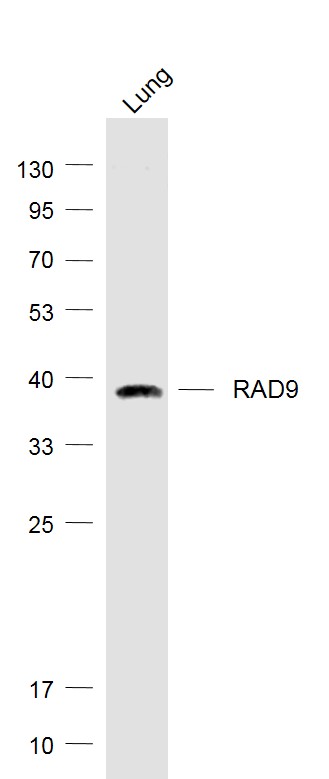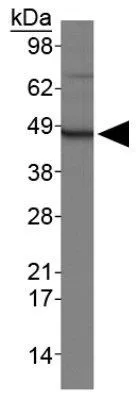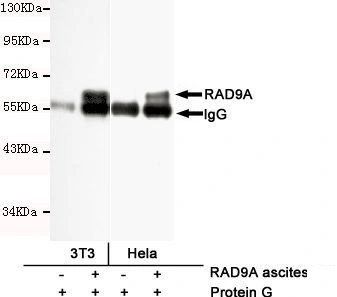![IHC-P analysis of colon tissue using GTX83736 RAD9A antibody [7B11]. Antigen retrieval : Heat-induced epitope retrieval by 10mM citrate buffer, pH6.0, 100oC for 10min. Dilution : 1:50 IHC-P analysis of colon tissue using GTX83736 RAD9A antibody [7B11]. Antigen retrieval : Heat-induced epitope retrieval by 10mM citrate buffer, pH6.0, 100oC for 10min. Dilution : 1:50](https://www.genetex.com/upload/website/prouct_img/normal/GTX83736/GTX83736_1784_IHC-P_w_23061420_582.webp)
IHC-P analysis of colon tissue using GTX83736 RAD9A antibody [7B11]. Antigen retrieval : Heat-induced epitope retrieval by 10mM citrate buffer, pH6.0, 100oC for 10min. Dilution : 1:50
RAD9A antibody [7B11]
GTX83736
ApplicationsWestern Blot, ImmunoHistoChemistry, ImmunoHistoChemistry Paraffin
Product group Antibodies
ReactivityHuman
TargetRAD9A
Overview
- SupplierGeneTex
- Product NameRAD9A antibody [7B11]
- Delivery Days Customer9
- Application Supplier NoteWB: 1:2000. IHC-P: 1:50. *Optimal dilutions/concentrations should be determined by the researcher.Not tested in other applications.
- ApplicationsWestern Blot, ImmunoHistoChemistry, ImmunoHistoChemistry Paraffin
- CertificationResearch Use Only
- ClonalityMonoclonal
- Clone ID7B11
- Concentration2 mg/ml
- ConjugateUnconjugated
- Gene ID5883
- Target nameRAD9A
- Target descriptionRAD9 checkpoint clamp component A
- Target synonymsRAD9, cell cycle checkpoint control protein RAD9A, DNA repair exonuclease rad9 homolog A, RAD9 homolog A, hRAD9
- HostMouse
- IsotypeIgG2a
- Protein IDQ99638
- Protein NameCell cycle checkpoint control protein RAD9A
- Scientific DescriptionComponent of the 9-1-1 cell-cycle checkpoint response complex that plays a major role in DNA repair. The 9-1-1 complex is recruited to DNA lesion upon damage by the RAD17-replication factor C (RFC) clamp loader complex. Acts then as a sliding clamp platform on DNA for several proteins involved in long-patch base excision repair (LP-BER). The 9-1-1 complex stimulates DNA polymerase beta (POLB) activity by increasing its affinity for the 3-OH end of the primer-template and stabilizes POLB to those sites where LP-BER proceeds - endonuclease FEN1 cleavage activity on substrates with double, nick, or gap flaps of distinct sequences and lengths - and DNA ligase I (LIG1) on long-patch base excision repair substrates. RAD9A possesses 3->5 double stranded DNA exonuclease activity. Its phosphorylation by PRKCD may be required for the formation of the 9-1-1 complex.
- ReactivityHuman
- Storage Instruction-20°C or -80°C,2°C to 8°C
- UNSPSC12352203

![WB analysis of HEK293T cells transfected with RAD9A plasmid (Right) or empty vector (Left) for 48 hrs using GTX83736 RAD9A antibody [7B11]. Loading : 5 ug per lane WB analysis of HEK293T cells transfected with RAD9A plasmid (Right) or empty vector (Left) for 48 hrs using GTX83736 RAD9A antibody [7B11]. Loading : 5 ug per lane](https://www.genetex.com/upload/website/prouct_img/normal/GTX83736/GTX83736_3866_WB_w_23061420_924.webp)
![WB analysis of various cell lines using GTX83736 RAD9A antibody [7B11]. Loading : 35 ug per lane WB analysis of various cell lines using GTX83736 RAD9A antibody [7B11]. Loading : 35 ug per lane](https://www.genetex.com/upload/website/prouct_img/normal/GTX83736/GTX83736_3867_WB_w_23061420_996.webp)
![IHC-P analysis of lung carcinoma tissue using GTX83736 RAD9A antibody [7B11]. Antigen retrieval : Heat-induced epitope retrieval by 10mM citrate buffer, pH6.0, 100oC for 10min. Dilution : 1:50 IHC-P analysis of lung carcinoma tissue using GTX83736 RAD9A antibody [7B11]. Antigen retrieval : Heat-induced epitope retrieval by 10mM citrate buffer, pH6.0, 100oC for 10min. Dilution : 1:50](https://www.genetex.com/upload/website/prouct_img/normal/GTX83736/GTX83736_1782_IHC-P_w_23061420_246.webp)
![IHC-P analysis of pancreas carcinoma tissue using GTX83736 RAD9A antibody [7B11]. Antigen retrieval : Heat-induced epitope retrieval by 10mM citrate buffer, pH6.0, 100oC for 10min. Dilution : 1:50 IHC-P analysis of pancreas carcinoma tissue using GTX83736 RAD9A antibody [7B11]. Antigen retrieval : Heat-induced epitope retrieval by 10mM citrate buffer, pH6.0, 100oC for 10min. Dilution : 1:50](https://www.genetex.com/upload/website/prouct_img/normal/GTX83736/GTX83736_1783_IHC-P_w_23061420_992.webp)
![IHC-P analysis of breast adenocarcinoma tissue using GTX83736 RAD9A antibody [7B11]. Antigen retrieval : Heat-induced epitope retrieval by 10mM citrate buffer, pH6.0, 100oC for 10min. Dilution : 1:50 IHC-P analysis of breast adenocarcinoma tissue using GTX83736 RAD9A antibody [7B11]. Antigen retrieval : Heat-induced epitope retrieval by 10mM citrate buffer, pH6.0, 100oC for 10min. Dilution : 1:50](https://www.genetex.com/upload/website/prouct_img/normal/GTX83736/GTX83736_1780_IHC-P_w_23061420_979.webp)
![IHC-P analysis of colon adenocarcinoma tissue using GTX83736 RAD9A antibody [7B11]. Antigen retrieval : Heat-induced epitope retrieval by 10mM citrate buffer, pH6.0, 100oC for 10min. Dilution : 1:50 IHC-P analysis of colon adenocarcinoma tissue using GTX83736 RAD9A antibody [7B11]. Antigen retrieval : Heat-induced epitope retrieval by 10mM citrate buffer, pH6.0, 100oC for 10min. Dilution : 1:50](https://www.genetex.com/upload/website/prouct_img/normal/GTX83736/GTX83736_1781_IHC-P_w_23061420_449.webp)







